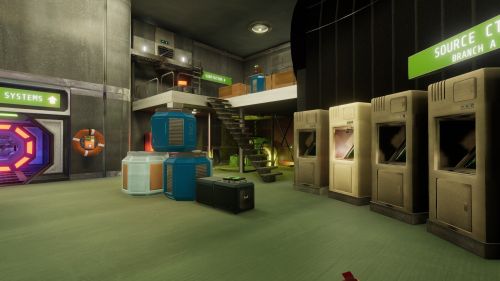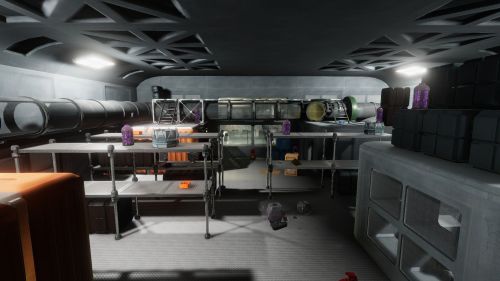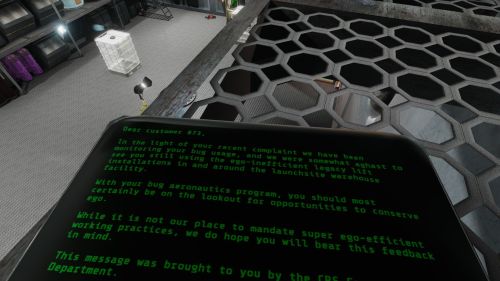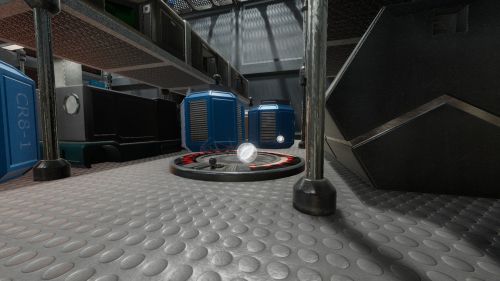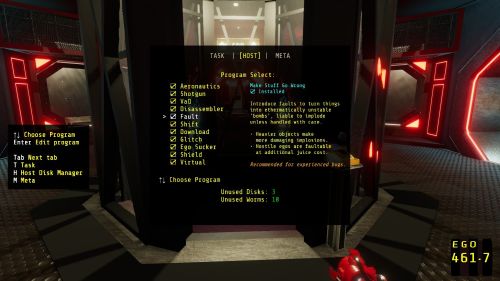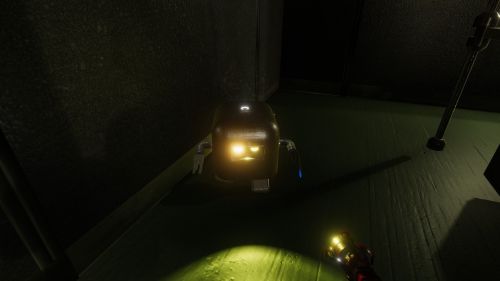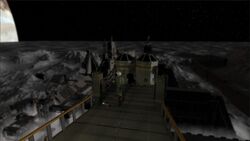RPG Codex Review: Ctrl Alt Ego
RPG Codex Review: Ctrl Alt Ego
Codex Review - posted by Infinitron on Sat 1 July 2023, 22:27:03
Tags: Ctrl Alt Ego; MindThunk[Review by udm]
Every once in a while, something gets mentioned on the Codex that no one’s heard of and which doesn’t get a lot of attention. We’re talking about little gameplay footage on Youtube, much less people streaming it on platforms like Twitch.
Ctrl Alt Ego is one of those games, and I’m really glad I stumbled on it.
Let’s talk about the game’s marketing first: people have claimed that it’s an immersive sim (not a term that I’m fond of because it could mean just about anything these days); there have also been comparisons drawn to classics like System Shock and Deus Ex. The posts and impressions I’ve read, prior to buying and after completing the game, make it sound like it would totally be right up the alley of someone who grew up on such games.
I’m happy to say that the game lives up to those claims.
Going beyond the buzzwords, Ctrl Alt Ego (CAE) is an interesting hybrid of different subgenres in the Action category. You play as a disembodied consciousness—really, I’m not making that up—that has the ability to possess and control different machines in first-person-perspective. The game’s levels are full of interactive elements with various paths that you can take. As such, there are many ways to complete an objective.
Now I have to admit, my first impressions were not all positive. There’s a certain jankiness to it that you normally find in low-budget games built on Unity. We’re not talking about the Eastern European sort which you find in games like ATOM and STALKER, the kind that would grow on you. This would be more on the level of shovelware jank that sports overdone bloom and asset flips in an attempt to make a quick buck off some poor sucker. It didn’t help that the game literally claims it’s impossible to get stuck, and I got stuck within the first 30 minutes of playing.
However, my bros Zombra and Jinn swore by it, and while I don’t always agree with their tastes, I know that the best way to gauge a game is to sink more time into it.
So I did.
Thank God I did.
The plot of CAE starts off with a simple premise: you are a disembodied consciousness following the instructions of one Dr Everyman to take out a virus that has infected a station.
At first glance, it seems to be a flimsy hook with a narrative that does not take itself seriously. What is this station? Who is Dr Everyman? Why must you obey him? I was bothered by these questions with no clear answers, at least during the initial chapters. Furthermore, there are many references and quotes that appear to break the fourth wall. However, as the plot progresses, you will find that there is more to it than meets the eye. Without spoiling much about the plot, I will say this: I greatly enjoyed its twists and turns, though the ending left much to be desired. The writing also has a strong hint of British humour, and if you have watched shows like Red Dwarf, you’ll feel right at home with its tongue-in-cheek and, at times, hyperbolic and sardonic nature.
At the beginning of the game, you will only be able to possess (or HOP to, using the game’s terminology) a few machines. Bugs are humanoid robots that float around, with your main chassis for most of the game being a bug called… well, Bug 22. Pups are small and cute trapezoidal boxes that bark, annoy enemies, and accomplish objectives in interesting ways. Other machines include CATs (stationary terminals through which Dr Everyman speaks to you),iPads Eye Pads, doors, and even mundane items like magnetic tape reels. If it has a sensor, it can be controlled.
As the game progresses, you will be introduced to more machines, and thus be able to control them too. However, this comes with a catch: you need to spend EGO, which is essentially a form of currency that can be earned by finding EGO orbs, controlling friendly machines, or destroying certain robots. EGO allows you to hack into and control hostile robots, including mobile turrets called MOMs and stationary ones called DADs. On higher difficulties, you’ll need to spend more EGO to take over hostiles, especially once they get alerted. I finished the game on the hardest difficulty (Severe), and taking over alerted hostiles was rarely an option because of how expensive it was.
Despite the possibilities of playing around with other machines, Bug 22 will still be your best friend because it’s the only robot that can be upgraded. There are three main types of upgrades you will find: Worms help Bug 22 unlock new skills, Upgrade Disks help you improve those skills, and MEM vendors upgrade your consciousness’s core abilities, like reducing the time taken to HOP to other machines.
And this is where the fun really begins: there are a total of 11 skills that Bug 22 can learn, with each skill having a small but varied selection of upgrades. These skills range from mundane ones like turning your arm into a shotgun, to turning it into a drill to break down other bots, to being able to convert any object into an unstable explosive. At harder difficulties, I would recommend against taking the straightforward options because alerted enemies automatically have a shield that makes them invincible (unless you have a certain upgrade in a certain skill that certainly instakills them).
Apart from the aforementioned, because of how varied the skills and upgrades are, you can accomplish tasks in almost any way you please so long as it is feasible within the constraints of the map. It never gets old converting an enemy MOM into a walking bomb, then having it enter a room full of other enemies. You can even do a pacifist run if you so please, turning yourself invisible and using the VacQ (a vacuum cleaner to suck up small objects, or to suck YOU towards big objects) to dart about swiftly from room to room. A lot of times, you don’t even have to use any of your skills if you don’t want to, as you can just hide behind boxes and wait for imminent threats to pass you by. Stealth isn’t light-based for those of you wondering, though it is still very much a viable option.
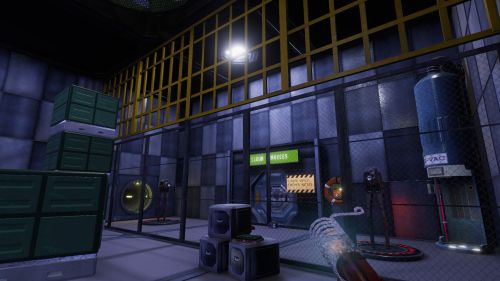
I figured out two ways to get through this challenge. Someone else might have figured out a couple more.
The maps are an absolute joy to explore and exploit. The initial chapters start off more like linear puzzle maps, though despite that, you still have many ways to overcome challenges: other than Bug 22's skills, you can also turn the environment to your advantage. Most items can be moved around and used as a tool of some sort; rarely will you enter a room that does not have at least one exploitable feature. It’s up to you how you want to play within the constraints of the game’s physics. Hide or confront, sabotage or ignore, there are so many ways to overcome a given problem.
The AI is also competent at tracking you down. If you try to hide behind a box right in front of a hostile, it will start to grow suspicious. When you move the box around, the hostile machine’s suspicion grows, until it decides it’s had enough of your nonsense and zaps away your cover. It is also quick to pick up on your presence if you take control of an enemy and start attacking them with their own mate. But, again, because there are so many ways to accomplish an objective, you can mix and match strategies. You can use a combination of stealth and brute force, or a combination of sabotage and subterfuge. It’s your playground.
There are a total of 8 chapters, and I must say that from Chapters 1 to 6, I treated the game more like a puzzle game than a simulation. It was very reminiscent of Portal in the way the maps of these 6 chapters were designed. I might be going out on a limb here, but it felt like the design philosophy for those earlier chapters was to only present the player with a series of challenges of escalating difficulty as games from the puzzle genre normally do. This was evident in the various MacGuffins that you had to go after, with a simple narrative to tie everything together. I did have a good time as each chapter got progressively more difficult, but I never really felt like I was playing an “immersive sim”.
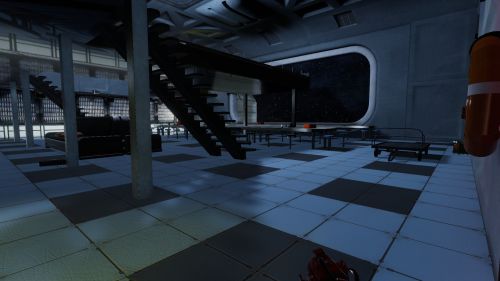
This cafeteria look familiar? I thought so too. The game wears its inspirations quite proudly on its sleeve.
And then, I was greeted by Chapters 7 and 8.
The map layout and design of these two chapters blew my mind. Not only were the maps huge, easily beating Chapters 1 to 6 in scale, but there was so much to do. There was so much to discover, so many access points and routes to traverse across the stations. Many games tend to fall apart towards the later levels, but CAE maintains a strong consistency in quality. At no point did I feel the developers dropped the ball and got sloppy to rush out the product. Bear in mind that this was developed by a team of two to three guys, making it even more mind-blowing!
I can’t say more about these last two chapters without ruining the surprise you get when you reach that point but be prepared to do a lot of exploration. Not only are they huge, but most major areas are interconnected in some way. It’s a very nice mix of closed corridors and big open spaces, two glorious playgrounds for you to mess around with whichever tools you fancy.
Let’s talk about the visuals of CAE. On a technical level, the game isn’t impressive. It looks like a typical Unity-engine FPS with too much Bloom. However, I appreciate the visual sharpness of objects and geometry. It feels like a pre-idTech 4 project, of the era where 3D games were pushing the technological envelope, not superbly pretty but with enough contrast that you could tell where everything was at a glance. I like it… mostly (more of what I didn’t like in the next section).
The audio is nice too in its own subtle way. Most of the game is filled with ambient background noises or music from certain machines like the Lifesaver. From time to time, some background music will fade in. It is reminiscent of how Thief does audio and music, unobtrusive and blending in well as one plays. More important are the audio cues from hostile enemies. You can clearly hear when a hostile MOM is passing by, or the mumbling of a hostile DAD giving away his Alertness level. Again, it’s not going to give you eargasm, but it’s very functional and I appreciate that in a game.
I really enjoyed CAE, but it’s not without its flaws. For one, the visuals can be nausea-inducing. Perhaps due to the way physics work, Bug 22 has the tendency to move around like a drunkard, causing the view to yaw left and right at times. When you HOP from one machine to another, it also feels like a mini rollercoaster ride. All of that added up, and you’ve got a good recipe for motion sickness. The developers have done a good job of alleviating some of that by reducing certain motion effects, but I would still advise anyone prone to getting motion sickness to take note of this.
Another issue I should mention is that there’s an abundance of Worms, so you’re basically able to unlock all skills by the end of the game. Furthermore, while the game is very open-ended in letting you play how you want to, some skills are more useful than others. The Shotgun, for instance, is useless at the hardest difficulty; in contrast, skills like Aeronautics (for flying) and Fault (to convert anything into a bomb) are a must-have regardless of difficulty. I feel fun should be prioritised over balance, but in this case, perhaps it’s taken a step too far when taking certain skills like the Shotgun can potentially soft-lock your progress.
Finally, and this is going to be a bit of a nitpick, the overall production value of the game feels low. Now this isn’t a problem to me, but when you go into the game, just be prepared for the initial “Unity store asset flip” feel. You’ll get past it after Chapter 1 though.
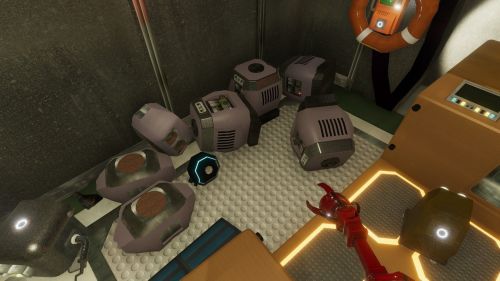
Every hostile bot that dies explodes violently into clutter that can be used for more nefarious purposes.
When I finished CAE, I was somewhat saddened by the realisation that it will be a while before another game like it comes along (similar to how I felt when I finished System Shock 2 and Deus Ex in 2000). Many games slap on the “immersive sim” tag, but few actually pull it off as well as CAE does. It certainly values fun over balance. In fact, it isn’t even a straight up FPS although you can play it like one. If you like games that offer a lot of freedom in approach, if you enjoy games like Deus Ex or even the recent Prey, then Ctrl Alt Ego is a game you should check out. It’s not expensive, you get a lot of bang for your buck—I clocked in over 50 hours when I finished the game—and hopefully MindThunk stays in business and produces more games like it.
Lost in Space
Every once in a while, something gets mentioned on the Codex that no one’s heard of and which doesn’t get a lot of attention. We’re talking about little gameplay footage on Youtube, much less people streaming it on platforms like Twitch.
Ctrl Alt Ego is one of those games, and I’m really glad I stumbled on it.
Let’s talk about the game’s marketing first: people have claimed that it’s an immersive sim (not a term that I’m fond of because it could mean just about anything these days); there have also been comparisons drawn to classics like System Shock and Deus Ex. The posts and impressions I’ve read, prior to buying and after completing the game, make it sound like it would totally be right up the alley of someone who grew up on such games.
I’m happy to say that the game lives up to those claims.
First Impressions
Going beyond the buzzwords, Ctrl Alt Ego (CAE) is an interesting hybrid of different subgenres in the Action category. You play as a disembodied consciousness—really, I’m not making that up—that has the ability to possess and control different machines in first-person-perspective. The game’s levels are full of interactive elements with various paths that you can take. As such, there are many ways to complete an objective.
Now I have to admit, my first impressions were not all positive. There’s a certain jankiness to it that you normally find in low-budget games built on Unity. We’re not talking about the Eastern European sort which you find in games like ATOM and STALKER, the kind that would grow on you. This would be more on the level of shovelware jank that sports overdone bloom and asset flips in an attempt to make a quick buck off some poor sucker. It didn’t help that the game literally claims it’s impossible to get stuck, and I got stuck within the first 30 minutes of playing.
However, my bros Zombra and Jinn swore by it, and while I don’t always agree with their tastes, I know that the best way to gauge a game is to sink more time into it.
So I did.
Thank God I did.
The Cogs of the Machine
The plot of CAE starts off with a simple premise: you are a disembodied consciousness following the instructions of one Dr Everyman to take out a virus that has infected a station.
At first glance, it seems to be a flimsy hook with a narrative that does not take itself seriously. What is this station? Who is Dr Everyman? Why must you obey him? I was bothered by these questions with no clear answers, at least during the initial chapters. Furthermore, there are many references and quotes that appear to break the fourth wall. However, as the plot progresses, you will find that there is more to it than meets the eye. Without spoiling much about the plot, I will say this: I greatly enjoyed its twists and turns, though the ending left much to be desired. The writing also has a strong hint of British humour, and if you have watched shows like Red Dwarf, you’ll feel right at home with its tongue-in-cheek and, at times, hyperbolic and sardonic nature.
At the beginning of the game, you will only be able to possess (or HOP to, using the game’s terminology) a few machines. Bugs are humanoid robots that float around, with your main chassis for most of the game being a bug called… well, Bug 22. Pups are small and cute trapezoidal boxes that bark, annoy enemies, and accomplish objectives in interesting ways. Other machines include CATs (stationary terminals through which Dr Everyman speaks to you),
As the game progresses, you will be introduced to more machines, and thus be able to control them too. However, this comes with a catch: you need to spend EGO, which is essentially a form of currency that can be earned by finding EGO orbs, controlling friendly machines, or destroying certain robots. EGO allows you to hack into and control hostile robots, including mobile turrets called MOMs and stationary ones called DADs. On higher difficulties, you’ll need to spend more EGO to take over hostiles, especially once they get alerted. I finished the game on the hardest difficulty (Severe), and taking over alerted hostiles was rarely an option because of how expensive it was.
Despite the possibilities of playing around with other machines, Bug 22 will still be your best friend because it’s the only robot that can be upgraded. There are three main types of upgrades you will find: Worms help Bug 22 unlock new skills, Upgrade Disks help you improve those skills, and MEM vendors upgrade your consciousness’s core abilities, like reducing the time taken to HOP to other machines.
Sprawling Playgrounds in Space
And this is where the fun really begins: there are a total of 11 skills that Bug 22 can learn, with each skill having a small but varied selection of upgrades. These skills range from mundane ones like turning your arm into a shotgun, to turning it into a drill to break down other bots, to being able to convert any object into an unstable explosive. At harder difficulties, I would recommend against taking the straightforward options because alerted enemies automatically have a shield that makes them invincible (unless you have a certain upgrade in a certain skill that certainly instakills them).
Apart from the aforementioned, because of how varied the skills and upgrades are, you can accomplish tasks in almost any way you please so long as it is feasible within the constraints of the map. It never gets old converting an enemy MOM into a walking bomb, then having it enter a room full of other enemies. You can even do a pacifist run if you so please, turning yourself invisible and using the VacQ (a vacuum cleaner to suck up small objects, or to suck YOU towards big objects) to dart about swiftly from room to room. A lot of times, you don’t even have to use any of your skills if you don’t want to, as you can just hide behind boxes and wait for imminent threats to pass you by. Stealth isn’t light-based for those of you wondering, though it is still very much a viable option.

I figured out two ways to get through this challenge. Someone else might have figured out a couple more.
The maps are an absolute joy to explore and exploit. The initial chapters start off more like linear puzzle maps, though despite that, you still have many ways to overcome challenges: other than Bug 22's skills, you can also turn the environment to your advantage. Most items can be moved around and used as a tool of some sort; rarely will you enter a room that does not have at least one exploitable feature. It’s up to you how you want to play within the constraints of the game’s physics. Hide or confront, sabotage or ignore, there are so many ways to overcome a given problem.
The AI is also competent at tracking you down. If you try to hide behind a box right in front of a hostile, it will start to grow suspicious. When you move the box around, the hostile machine’s suspicion grows, until it decides it’s had enough of your nonsense and zaps away your cover. It is also quick to pick up on your presence if you take control of an enemy and start attacking them with their own mate. But, again, because there are so many ways to accomplish an objective, you can mix and match strategies. You can use a combination of stealth and brute force, or a combination of sabotage and subterfuge. It’s your playground.
There are a total of 8 chapters, and I must say that from Chapters 1 to 6, I treated the game more like a puzzle game than a simulation. It was very reminiscent of Portal in the way the maps of these 6 chapters were designed. I might be going out on a limb here, but it felt like the design philosophy for those earlier chapters was to only present the player with a series of challenges of escalating difficulty as games from the puzzle genre normally do. This was evident in the various MacGuffins that you had to go after, with a simple narrative to tie everything together. I did have a good time as each chapter got progressively more difficult, but I never really felt like I was playing an “immersive sim”.

This cafeteria look familiar? I thought so too. The game wears its inspirations quite proudly on its sleeve.
And then, I was greeted by Chapters 7 and 8.
The map layout and design of these two chapters blew my mind. Not only were the maps huge, easily beating Chapters 1 to 6 in scale, but there was so much to do. There was so much to discover, so many access points and routes to traverse across the stations. Many games tend to fall apart towards the later levels, but CAE maintains a strong consistency in quality. At no point did I feel the developers dropped the ball and got sloppy to rush out the product. Bear in mind that this was developed by a team of two to three guys, making it even more mind-blowing!
I can’t say more about these last two chapters without ruining the surprise you get when you reach that point but be prepared to do a lot of exploration. Not only are they huge, but most major areas are interconnected in some way. It’s a very nice mix of closed corridors and big open spaces, two glorious playgrounds for you to mess around with whichever tools you fancy.
Groovy Vibes
Let’s talk about the visuals of CAE. On a technical level, the game isn’t impressive. It looks like a typical Unity-engine FPS with too much Bloom. However, I appreciate the visual sharpness of objects and geometry. It feels like a pre-idTech 4 project, of the era where 3D games were pushing the technological envelope, not superbly pretty but with enough contrast that you could tell where everything was at a glance. I like it… mostly (more of what I didn’t like in the next section).
The audio is nice too in its own subtle way. Most of the game is filled with ambient background noises or music from certain machines like the Lifesaver. From time to time, some background music will fade in. It is reminiscent of how Thief does audio and music, unobtrusive and blending in well as one plays. More important are the audio cues from hostile enemies. You can clearly hear when a hostile MOM is passing by, or the mumbling of a hostile DAD giving away his Alertness level. Again, it’s not going to give you eargasm, but it’s very functional and I appreciate that in a game.
In Space, No One Can Hear You Vomit
I really enjoyed CAE, but it’s not without its flaws. For one, the visuals can be nausea-inducing. Perhaps due to the way physics work, Bug 22 has the tendency to move around like a drunkard, causing the view to yaw left and right at times. When you HOP from one machine to another, it also feels like a mini rollercoaster ride. All of that added up, and you’ve got a good recipe for motion sickness. The developers have done a good job of alleviating some of that by reducing certain motion effects, but I would still advise anyone prone to getting motion sickness to take note of this.
Another issue I should mention is that there’s an abundance of Worms, so you’re basically able to unlock all skills by the end of the game. Furthermore, while the game is very open-ended in letting you play how you want to, some skills are more useful than others. The Shotgun, for instance, is useless at the hardest difficulty; in contrast, skills like Aeronautics (for flying) and Fault (to convert anything into a bomb) are a must-have regardless of difficulty. I feel fun should be prioritised over balance, but in this case, perhaps it’s taken a step too far when taking certain skills like the Shotgun can potentially soft-lock your progress.
Finally, and this is going to be a bit of a nitpick, the overall production value of the game feels low. Now this isn’t a problem to me, but when you go into the game, just be prepared for the initial “Unity store asset flip” feel. You’ll get past it after Chapter 1 though.
Concluding Thoughts

Every hostile bot that dies explodes violently into clutter that can be used for more nefarious purposes.
When I finished CAE, I was somewhat saddened by the realisation that it will be a while before another game like it comes along (similar to how I felt when I finished System Shock 2 and Deus Ex in 2000). Many games slap on the “immersive sim” tag, but few actually pull it off as well as CAE does. It certainly values fun over balance. In fact, it isn’t even a straight up FPS although you can play it like one. If you like games that offer a lot of freedom in approach, if you enjoy games like Deus Ex or even the recent Prey, then Ctrl Alt Ego is a game you should check out. It’s not expensive, you get a lot of bang for your buck—I clocked in over 50 hours when I finished the game—and hopefully MindThunk stays in business and produces more games like it.





